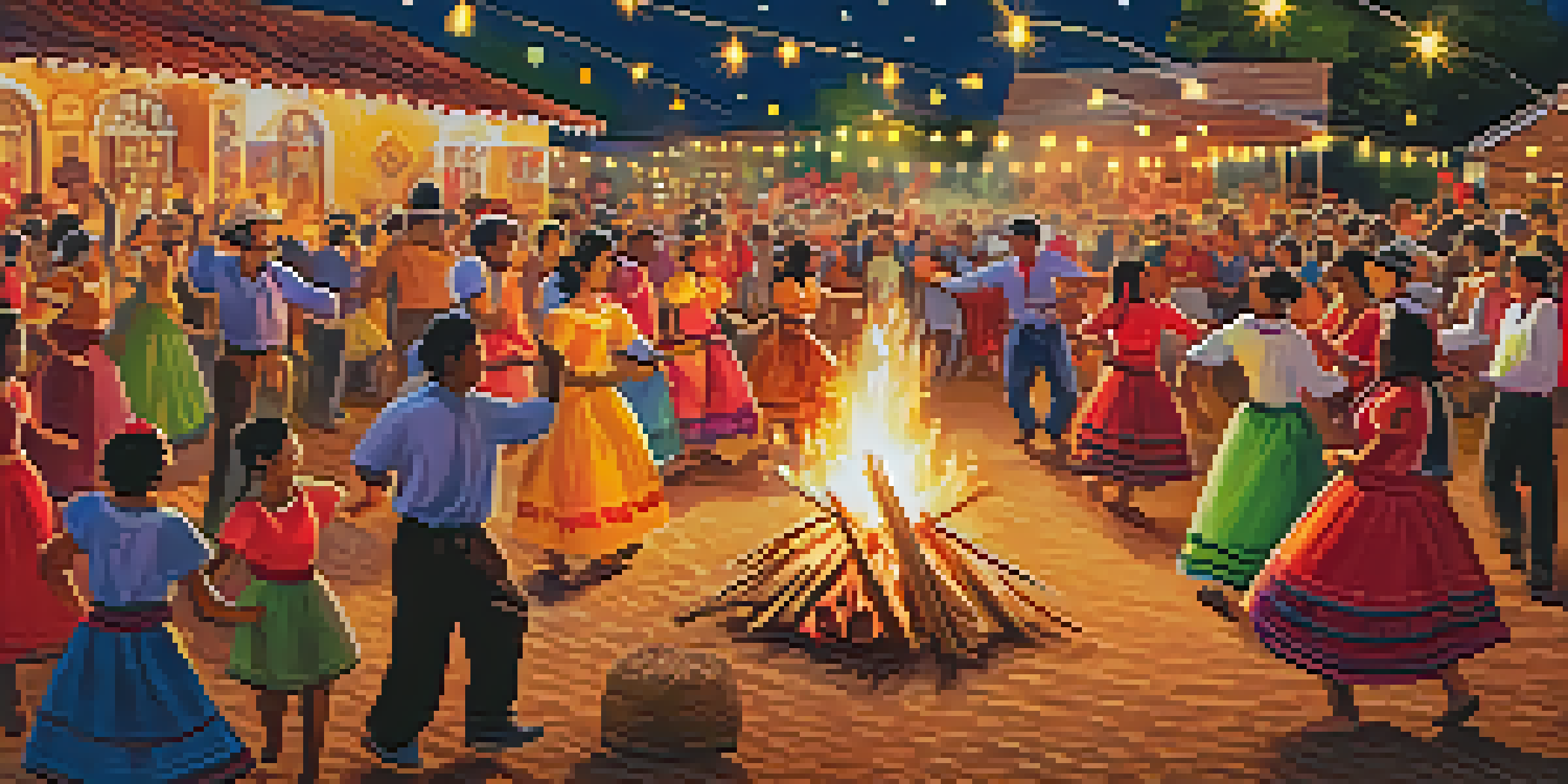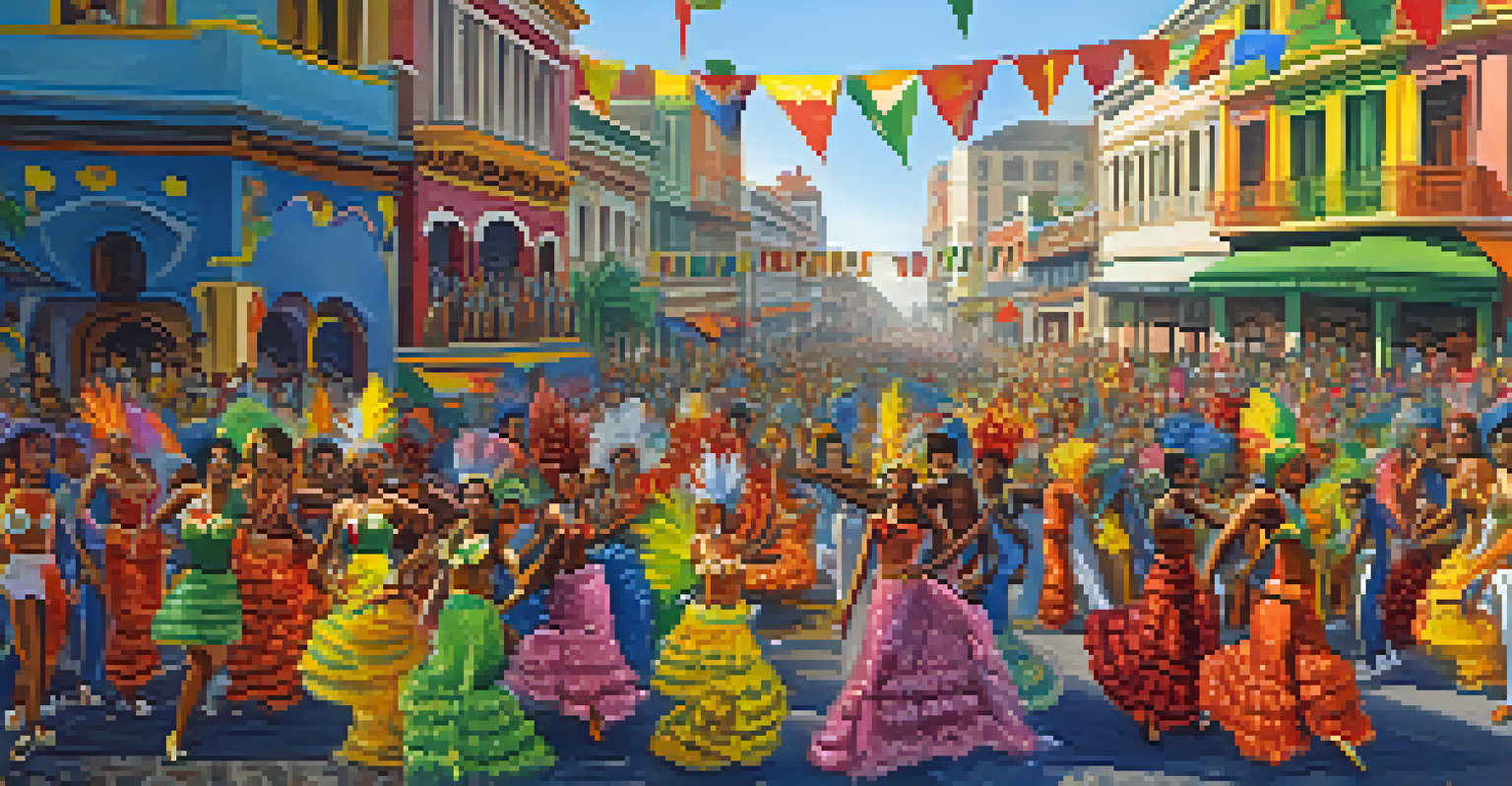Exploring the Folklore of Brazil During Festas

The Heart of Brazilian Folklore: An Overview
Brazilian folklore is a vibrant tapestry woven from the country's diverse cultures, including Indigenous, African, and European influences. This rich heritage is especially evident during festas, where stories, music, and dance bring the past to life. These celebrations honor various saints, seasonal changes, and historical events, creating a unique blend of spirituality and community.
Folklore is the heart of a culture—it's the stories that bind us together and connect us to our roots.
One of the most captivating aspects of Brazilian folklore is its emphasis on oral traditions, where tales are passed down through generations. These stories often feature mythical creatures, legendary heroes, and moral lessons that resonate with everyday life. The connection between folklore and the festas enhances the experience, allowing participants to engage deeply with their cultural roots.
In essence, Brazilian folklore is not just a collection of stories—it's a living tradition that shapes the identities of people across the nation. Each festa offers a unique glimpse into this world, inviting everyone to participate in a collective memory that is both personal and communal.
Festa Junina: A Celebration of Harvest and Folklore
Festa Junina, celebrated in June, is one of Brazil's most beloved festivals, marking the harvest season. The festivities are rich with folklore, showcasing traditional dances like the quadrilha, which reenacts rural life. Participants dress in colorful costumes, embodying characters from rural tales, and immersing themselves in a world where folklore comes to life.

Food plays a significant role during Festa Junina, with dishes like pamonha (corn pudding) and canjica (sweet corn porridge) taking center stage. These culinary delights are steeped in tradition, mirroring the agricultural roots of the celebration. Sharing these meals creates a sense of togetherness, reinforcing community bonds and the collective memory of the past.
Folklore Enriches Brazilian Culture
Brazilian folklore, shaped by diverse influences, is a living tradition that enhances cultural identity and community during festivals.
As night falls, bonfires illuminate the sky, and laughter fills the air. The stories shared around these fires often include legends of the 'Saci Pererê,' a mischievous one-legged figure known for his pranks. This blend of music, dance, food, and storytelling makes Festa Junina a rich embodiment of Brazilian folklore.
Carnaval: Folklore Meets Extravagance
Carnaval is perhaps the most famous festa in Brazil, renowned for its vibrant parades and exuberant celebrations. Beyond the dazzling costumes and samba rhythms lies a deep connection to folklore, with many samba schools drawing inspiration from traditional stories and legends. This fusion transforms Carnaval into a grand narrative that celebrates Brazilian identity and cultural diversity.
Cultural identity is shaped by the stories we tell and the traditions we celebrate, making folklore a vital part of who we are.
The character of the 'Boi Bumbá' is one example of how folklore influences Carnaval. Originating from the Amazon, this tale of a resurrected bull is often depicted in elaborate floats and performances. As the story unfolds during the parade, spectators are captivated not only by the spectacle but also by the cultural significance behind it.
Ultimately, Carnaval serves as a platform for storytelling, where folklore is reinterpreted and celebrated in a contemporary context. This unique blend of past and present allows participants to connect with their heritage while also embracing the joy of the moment, making Carnaval a fascinating exploration of Brazilian folklore.
The Role of Myths and Legends in Brazilian Culture
Myths and legends are the backbone of Brazilian folklore, offering insights into the values and beliefs of its people. Stories like 'Iara,' the water goddess, and 'Curupira,' the guardian of the forest, serve not only as entertainment but also as moral guides. These narratives remind us of the importance of nature, respect, and community values, elements that are essential during festas.
During festivities, these myths often come alive through theatrical performances, music, and dance. Participants may dress as their favorite characters, reenacting stories that have shaped their cultural identity. This interactive approach encourages a deeper understanding of the folklore and its relevance in today’s society.
Festas Celebrate Regional Diversity
Regional variations in Brazilian folklore are showcased during festas, allowing communities to honor their unique stories and traditions.
Moreover, the presence of these legends during festas fosters a sense of belonging and continuity. As people share these stories, they create a bridge between generations, ensuring that the wisdom and lessons of the past are not lost but are instead celebrated and cherished.
Regional Variations: Folklore Across Brazil
Brazil's vast geography means that folklore varies significantly from region to region, with each area contributing its unique flavor to the collective narrative. In the Northeast, festivals like 'Festa de São João' feature tales of the sertão, while the South may highlight stories of gauchos and their traditions. This diversity enriches the overall tapestry of Brazilian folklore, making each festa a distinct experience.
For example, in Bahia, Candomblé blends African spiritual practices with local customs, showcasing a unique folklore that highlights the importance of ancestry and spirituality. The vibrant celebration of Orixás, or deities, during festas reflects a deep reverence for heritage and community, drawing participants into a rich cultural experience.
These regional variations not only celebrate local folklore but also foster a sense of pride and identity. By sharing these unique stories during festas, communities reinforce their cultural significance and create a space where everyone can come together to honor their roots.
Music and Dance: The Language of Folklore
Music and dance are integral components of Brazilian festas, acting as a universal language that communicates folklore in an engaging way. Traditional rhythms, such as forró and samba, often tell stories of love, struggle, and community, inviting participants to join in and experience the narratives firsthand. This rhythmic storytelling fosters a sense of unity and joy among attendees.
During festivities, dance becomes a way to express cultural identity and history. The movements often reflect the stories being told, allowing participants to embody the folklore and connect with it on a personal level. This interactive aspect of dance not only entertains but also educates, keeping the folklore alive and relevant.
Music and Dance Unite Communities
Music and dance serve as vital expressions of Brazilian folklore, fostering unity and cultural connection among participants during celebrations.
As people come together to dance and celebrate, they forge connections that transcend language and cultural barriers. This powerful aspect of Brazilian festas ensures that folklore is not only preserved but also evolves, adapting to contemporary influences while remaining rooted in tradition.
The Impact of Folklore on Brazilian Identity
Folklore plays a crucial role in shaping Brazilian identity, offering a sense of belonging and pride in cultural heritage. Through the stories, music, and traditions celebrated during festas, Brazilians connect with their roots and each other. This cultural bond is particularly evident during national celebrations, where the shared experience of folklore fosters unity amidst diversity.
In a rapidly globalizing world, these traditions serve as a reminder of the importance of cultural preservation. By participating in festas and embracing their folklore, Brazilians ensure that their history and values are passed down to future generations. This commitment to preserving their identity allows them to navigate modernity while staying connected to their past.

Ultimately, the impact of folklore on Brazilian identity is profound. It nurtures a sense of community and belonging, allowing individuals to celebrate their uniqueness while also embracing the rich diversity of their nation. During festas, this celebration of identity shines brightly, inviting everyone to join in the dance of tradition.